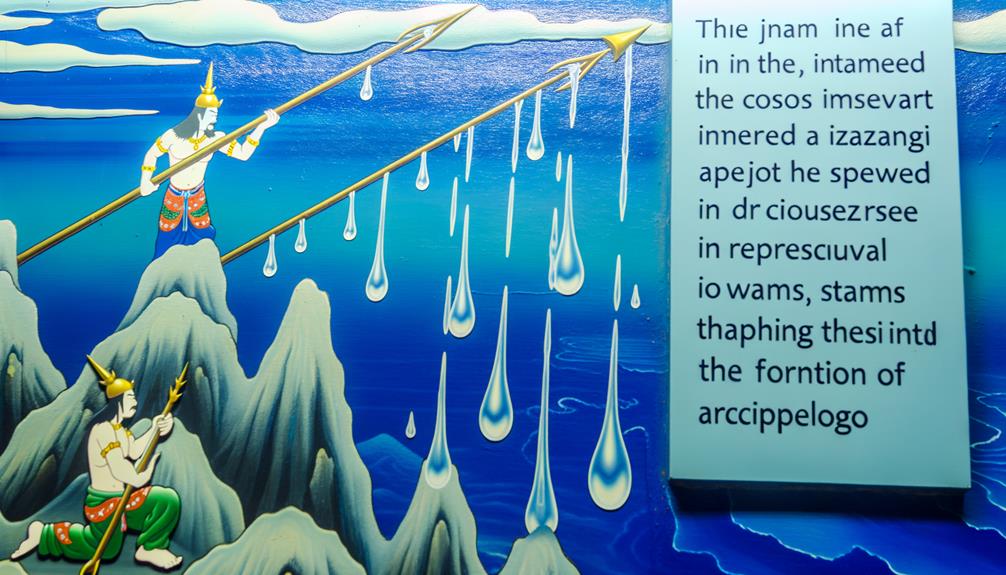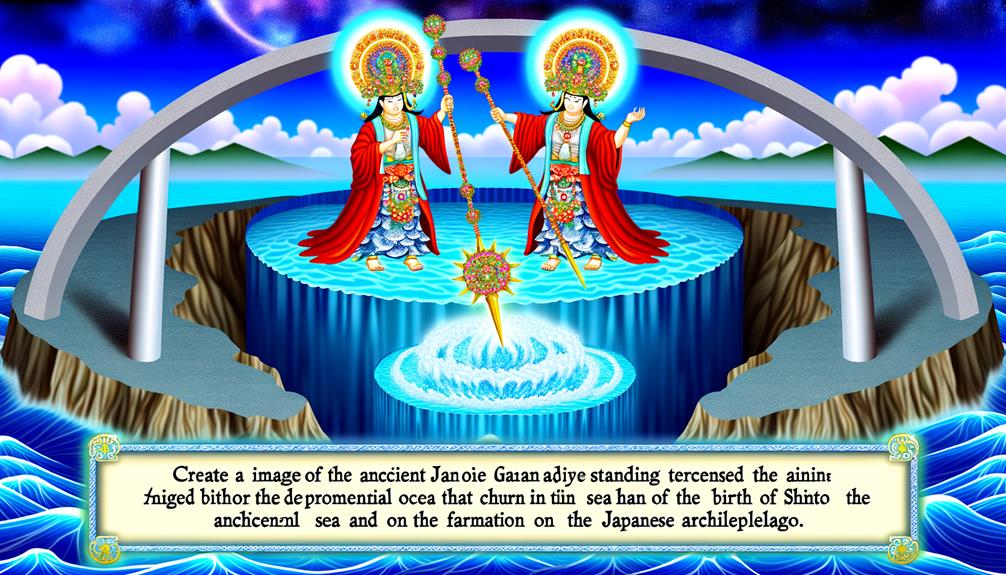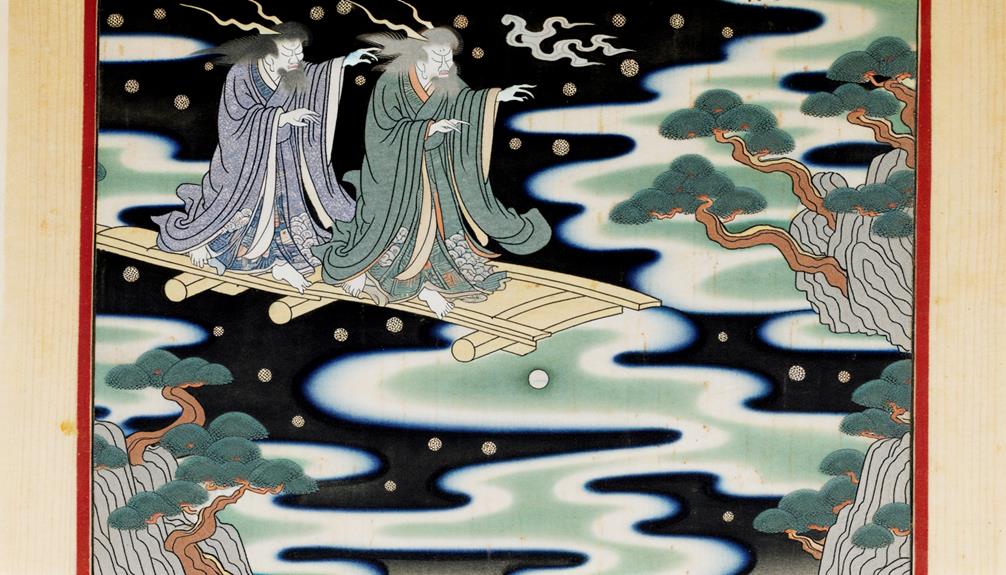The old saying, 'out of chaos comes order,' couldn't be more apt than in the case of the age-old Shinto tale of Izanagi and Izanami. This ancient story gives us a glimpse into the origins of the Japanese islands and countless gods, all born from the sacred bond between these two divine beings. Their tale, brimming with elements of myth and culture, serves as a fascinating insight into the human psyche, touching upon love, death, sorrow, and the perpetual cycle of life and decay. I've spent considerable time studying this narrative, and trust me, it is as deep as the sea that Izanagi and Izanami churned into being. So, how about we dig a bit deeper? What we see on the surface is just a scratch on the surface; there's a whole world hidden underneath, ready to be discovered.
Izanagi and Izanami: The Divine Pair

At the core of Japan's birth story, we find the divine duo Izanagi and Izanami. They're quite the characters, showing up front and centre, stirring the ancient ocean to create the first chunk of land and popping out a whole host of gods. Sure, they stumbled a bit at first, but they dusted themselves off and kept going. Their tale isn't just about creation; it's also a nod to their tenacity and courage.
Their partnership had a rocky start, with their first offspring, the misshapen deity Hiruko, not turning out quite right. But they didn't let that stop them. They went back to the drawing board, fixed their ritual mistakes and before you knew it, they were making all kinds of gods and islands. But life wasn't all sunshine and rainbows. Izanami had a tough time giving birth to the fire god Kagutsuchi, which sadly caused her death and a journey to Yomi, a pretty grim underworld.
When Izanagi managed to get out of Yomi, he cleansed himself in the sea. And guess what? This act brought forth two major players in Japanese mythology: the sun goddess Amaterasu and the storm god Susanoo. This bathing ritual is reflected in Shintō practices, seen as a symbol of starting afresh.
The story of Izanagi and Izanami is a key part of the Japanese creation narrative, emphasizing their crucial role in forming the godly line-up that's a big part of Japan's mythic tales. Their story is a gripping account of creation, resilience, and the circle of life and death.
The Formation of Japan's Islands

Let's chat about how Japan's islands came to be. Picture this: Izanagi and Izanami, armed with a jewel-decked spear, set the ocean into a whirl of creation, resulting in the land we now call Japan. From their perch on the heavenly bridge, they plunged the spear into the ancient sea. When they lifted it, the sea water dripping from the spear's tip gathered and formed the first island, Onogoro-shima. This was the place where the original gods held a divine wedding ceremony.
When you look deeper into these old legends, you find that the couple didn't stop there. They continued to create more islands, like Awaji and Shikoku, which are part of the Eight Great Islands of Japan. Their first child, Hiruko, sadly didn't make it, but found his place in the divine scheme of things as the protector of fishermen.
This story also tells us about the heavenly pillar, a divine boundary or a special place where the gods worked their creative magic. This legend, like many others, not only gives us an insight into how Japan's islands were formed, but also how over 800 kami, or gods, came into existence in the Shinto religion.
Izanami's Death and Izanagi's Despair
Let's shift our attention from the heavenly creations and the celestial pillar to a more sorrowful part of the story. We're now focusing on the sad death of Izanami and the deep despair of Izanagi. Izanami met a tragic end due to injuries sustained during the birth of Kagutsuchi, the god of fire. This event left a significant mark on Japanese history.
Izanagi, overwhelmed by his sorrow, decided to venture into the Land of the Dead, also known as Yomi, to bring back Izanami. What he encountered in Yomi was a world far removed from the vibrant life they had once nurtured together. He found Izanami's decaying body, a sight so disturbing that Izanagi decided to run away, with an angry Izanami following close behind.
In his frantic attempt to escape, Izanagi blocked the entrance to Yomi with a large rock. This act effectively ended the connection between Izanami and Izanagi. Once he returned to the land of the living, Izanagi cleansed himself in the sea. This act unintentionally resulted in the birth of new gods, including the sun goddess Amaterasu and the storm god Susanoo. The story of Izanami's death and Izanagi's despair is a crucial part of the Shintō religion, representing themes of life, death, and rebirth.
Birth and Significance of Shinto Gods

Let's take a deeper look into the intriguing narrative of the birth and role of Shinto gods in the Japanese creation story. The Izanagi and Izanami tale, as recorded in the History Encyclopedia, highlights the emergence of various kami or deities.
In the beginning, Izanagi and Izanami stirred the primeval ocean with their spear, bringing the first landmass into existence. This event symbolizes not only the birth of the Japanese islands but also underscores the importance of marital union in the creation process. Their first offspring, Hiruko, was born deformed, which highlights the unpredictable aspect of creation.
The story takes a dramatic turn with Izanami's death during childbirth. Izanagi's daring escape from Yomi, the land of darkness, resulted in the emergence of several key deities. Notably, the birth of Amaterasu, the sun goddess, and Susanoo, the storm god, among the Seven Generations of kami born from Izanagi, underscores the value placed on life, light, and vitality in Shintoism.
Izanagi's purification act after his escape from Yomi is a pivotal point in the narrative. This act represents not only the birth of additional kami but also underlines the crucial role of purification rituals in Shintoism.
In a nutshell, the birth and role of Shinto gods in the Izanagi and Izanami story are integral to understanding Japanese history and cultural customs.
Cultural Influence: Art and Literature

Let's have a chat about the cultural impacts of art and literature. Picture this: The ancient creation myth of Izanagi and Izanami, has left a significant mark on countless artistic expressions and literary works across Japan. These two characters, Izanagi (he who invites) and Izanami, were given a monumental task—to create the world's first lands using a jeweled spear. This captivating tale, preserved in the Nihon Shoki, Japan's oldest book, continues to spark the imagination of artists and writers today.
Just look at the extent of their influence:
| Influence | Art | Literature |
|---|---|---|
| Izanagi and Izanami | Showcased in paintings, sculptures. | Frequent theme in stories, poems. |
| Creation Story | Shaped the design of shrines. | Forms the foundation for many creation myths. |
| Sun Goddess | Symbol of light, life in art. | Main character in numerous tales. |
| Storm God | Represents power, destruction in art. | Often cast as the villain in literature. |
| Sacred Rituals | Featured in ceremonial art. | Incorporated as narrative elements in epics. |
Their legend has inspired the creation of hallowed art forms, such as the wedded rocks of Meotoiwa, which stand as a symbol of their union. From the sun goddess, the embodiment of life, to the storm god, the symbol of destruction, these figures are deeply woven into the fabric of Japanese art and literature, highlighting the cultural impact of Izanagi and Izanami's creation story.
Frequently Asked Questions
How Did Izanagi and Izanami Create the World?
Have you ever wondered how the world came to be, according to ancient legends? Well, sit back and let me tell you a spellbinding tale. Our story begins with Izanagi and Izanami, who are no ordinary beings, but extraordinary deities from legend. Picture them standing at the brink of a vast, unformed ocean.
Now, imagine them wielding a spear adorned with precious jewels. They stirred the endless ocean with this spear. And guess what? This simple action triggered the creation of the world! Islands started sprouting from the ocean surface, and gods came into existence. Quite a spectacle, wouldn't you agree?
However, not all was well. Following a heartbreaking event involving childbirth, Izanagi and Izanami went their separate ways. But the story doesn't end there. You see, from the ritual Izanagi performed to cleanse himself, additional deities were born. So, in a way, even their separation contributed to the creation of the world. Fascinating, isn't it?
What Do Izanagi and Izanami Symbolize?
Alright, let's talk about Izanagi and Izanami from Japanese mythology. These two are all about creation and order. Picture them as the architects of the Earth, bringing together the necessary harmony and balance. The children they had? Well, they symbolize the world's continuous evolution. Plus, Izanagi and Izanami have quite a focus on spiritual cleansing and renewal, which adds another intriguing layer to their mythology.
What Is the Myth of the Japanese Islands Creation?
Did you know about the fascinating tale of how the Japanese islands came into being? According to Japanese folklore, a sacred pair of deities played a crucial role in their creation. The story goes that these divine beings churned the sea using a spear, and as droplets fell from it, voila – they transformed into the Japanese islands. Quite an enchanting tale, isn't it?
What Is the Legend of Japan's Creation?
Have you ever wondered about the story behind Japan's creation? It's quite an intriguing tale! The narrative kicks off with a vast ocean, which was set into motion by two divine beings, Izanagi and Izanami. As they stirred the waters, the first landmass came into being. This wasn't their only contribution, though. These deities also had offspring who became additional gods and islands, playing a vital role in the formation of Japanese mythology and culture.

